Day 1 Session Notes–Zero to One: Co-Creating Operating Models with your Team
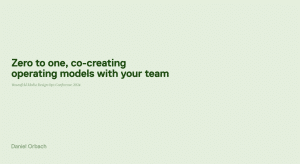
— Got to start by thanking conference team for organizing event and Corey for sharing his incredible story
- I was watching Edge of Tomorrow a few weeks ago, and it’s terrible when job hunting feels like you are stuck in a time loop
— I’m here to talk about models of co-creation with your team
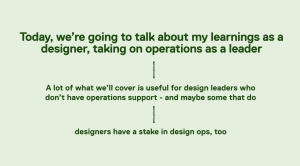
— Will talk about what I learned about design leader taking on ops
- Info will be useful for design leader who doesn’t have ops support and for someone who needs the support
— Designers have stake in DesignOps too
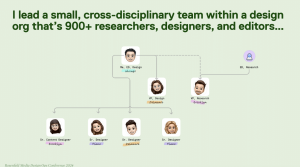
— I lead a small cross-disciplinary team at JP Morgan Chase (JPMC), which is distributed across U.S. and have 900 person research, design, and content org, and 70 person DesignOps that doesn’t have capacity to support day-to-day work
- What if all designers were design operators?
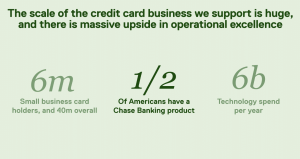
— Scale of JPMC is huge, with 7 billion in spend in tech per year
- Scale is amazing
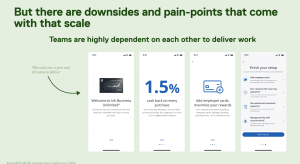
— Scale is our opportunity and greatest weakness, as we are highly dependent on others to deliver work
- For example, it took over a year and ten teams to ship the four screens above
— With such a hard time getting stuff out the door, operational excellence should be part of strategy
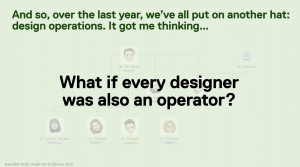
— Thought about idea if everyone on team was responsible for operations
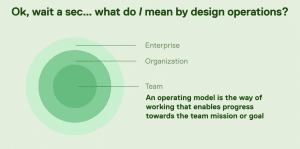
— But what does Daniel mean about DesignOps, as we are operating at the team level
- How can we work to enable progress to mission or goal? How does team get stuff done?
— This might not ladder up to enterprise, depending on org, complexity and team talent
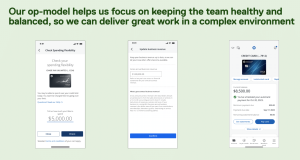
— So what does my team do specifically?
- Support things small businesses need to run business, such as letting people know what revenue of business is and home screen for the app
- Scale is tremendous, with 100 million impact over five years for changing a text field
- Doing anything at scale would be impactful
- How to get past this then?
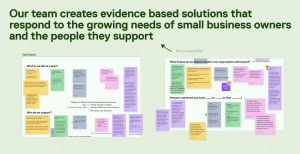
— Our operating model as advancing shared mission or goal, and asked for questions
- Job as team
- Who do we support
- What impact do we want to create in org? And beyond the org?
— Discussions coalesced to the purpose statement shown on the screen
— Purpose is most foundational cultural pillar for team to help them move through difficult movements, and why to work in certain way
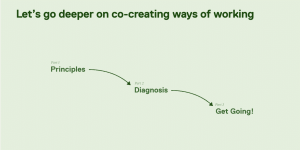
— We’ll need to go deeper as shared purpose not enough
- Principles: How to think about about teaming, and how operator supporting team should think about high and low maturity in teams
- Diagnosis: How do you know if you are there? And extract signal from noise in complicated work environment?
- Get Going: Once you know, where do you start? And will talk about things you can do.
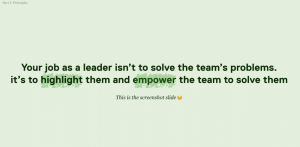
— As leader, many styles of leadership
- Co-Creation: The first step is highlight problems team has, and second is empowering team to solve the problem
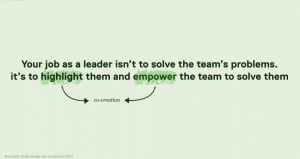
— Intersection at both things is co-creation
- Agile sprints might slow down, but we are exposing problems team has, and working iteratively to solve those problems
- We need to go slow to go fast
— When teams solve their own problems, can make impacts on their own and raise bar for work they do, and you can invest in team development
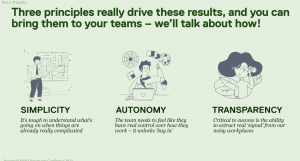
— Three principles
- Simplicity: From John Gall, Gall’s Law is that all complicated systems that work evolved from simpler systems that worked
- To build complex system, start small and evolve over time to something more complicated
- Example of Internet— which started as way for academics to send email
- Autonomy: Team needs to feel real control over how they work, and commit to changes, which unlocks ability to co-create vs parent-child relationship of tradition management
- Transparency: Understand how team is spending time and how work is done, will let your work through folks on team than being at every meeting
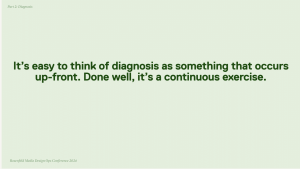
— So how to understand these things?
- Can’t do it right away
— Diagnosis will happen outside your work plans
- Culture of team
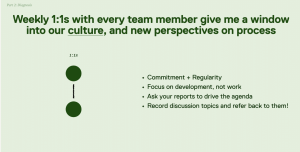
— First one
- Weekly one-on-ones as clear signal, and Scaling People has good information on this
- Focus on development and problem solving individual and what they need help with
- Asking reports to drive the agenda
- Reinforces idea of autonomy, and ask them to think about what they want to talk about with you
- Platform to record topics, and go back to something a tpoint in time
— Weekly one-on-ones might not scale, but ideas generated by them are
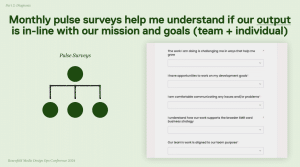
— We also have a pulse survey launched once a month
- Grasp if output aligned with mission and goals
— Seeing if work aligned with team purpose and making sure goals allow you to take team temperature
- Doing this repeatedly gets strengths and development points for team
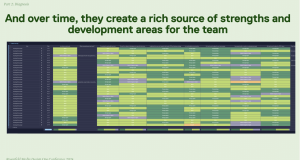
— Goal is to baseline team performance on certain areas, and providing a platform to talk about it with the team
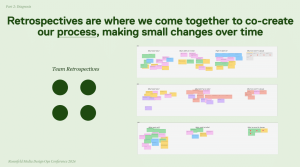
— Retrospectives are something we’ve all done, and nothing ground-breaking beyond tried and true practices like what to do going forward
— What we add to retrospectives:
- Commit to direct feedback [not rude, but coming from place of caring]
- Healthy friction and conflict can improve things on teams
- Commitment to regularity, not skipping retrospectives, and moving meetings to accommodate them
- Third of showing up as leader to get conversations between folks on the team and owning conversation in place
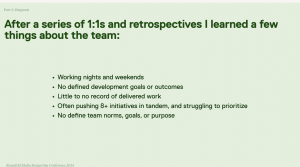
— I had several insights about my team the based on retrospectives
- Learned a few things, that people were working nights and weekends
- No defined development goals and outcomes
- People were context switching like crazy and struggles to prioritize
— This might be describing your team, right now
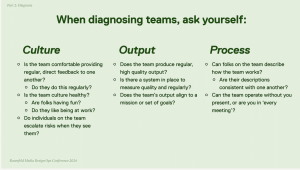
— When you diagnose team across domains questions to ask yourself include
- Healthy culture: Do they like being at work?
- Output: Producing regular high quality output systems to measure results
- Process: Can people describe how the process works independently of each other?
- Asking this and comparing answers to questions will tell you a lot
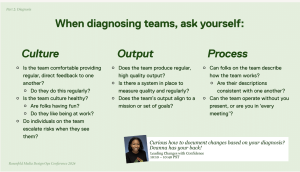
— For taking these changes and going forward, recommend Deanna’s talk on leading changes with confidence
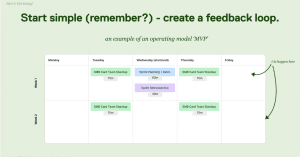
— To get going, start simple and start with basic operating model to create a feedback loop
— Our loop was simple and started with a stand-up twice a week, and plan next two weeks
- If a team is pushing eight things at once, they can’t stick to three-month plan
- Plan every two weeks, and retrospective to bake things in
— Over time it improves to meet the team needs
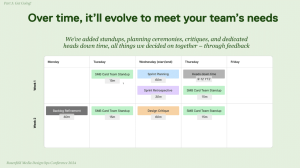
— Over time, the loop will evolve to meet needs of team, like dedicated problem solving time for content and research and heads-down time
- Core is that we did decisions together through one-on-ones, retrospectives, and workshopped to improve
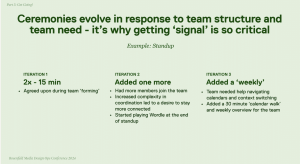
— Example of stand-up can be seen above
- Evolved over time based on team structure and feedback
— We came up with team purpose, and increase in complexity of coordination and fully distributed remote team
- Played Wordle at end of stand-up to help keep meeting tight
— Some changes you can’t plan on that, are organic and emergent, so think about them as unique pieces of team culture
— We also have a weekly stand-up for people to understand where they need to be if conflicts existed within the team and understand what was going on at the bigger picture
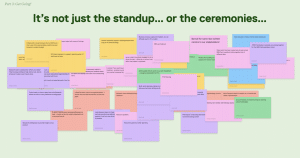
— Our team problem solved issues with documentation, taking PTO, stakeholder management
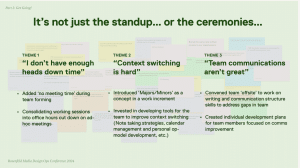
— Common themes emerged
- Theme 1: Not enough heads-down time
- Allowing no meeting times during team formations
- Theme 2: Context switching between projects is hard
- Introduced major and minor projects in a work increment to clarify areas of focus
- Investing in tools for team to improve switching
- Theme 3: Team communications weren’t great
- Had team onsite to work on team writing and communication structure skills to address gaps in team
- Created individual development plans for team members focused on communication improvements
— Ways to problem solve this, such as giving people on problem to focus on
- Solutions will come from team, and we should allow space to emerge from the team to bake into the operating model
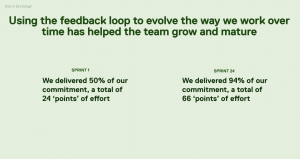
— This process works!
- Feedback loop has had tremendous impact
— First sprint was bad, but Sprint 24 delivered 94% of commitments, at 2.5x of time to delivery, compared to previous baseline
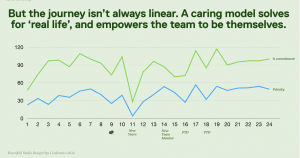
— Although I could have stopped in previous slide, let’s talk about non-linear nature of work, as our needs to solve for work and for real-life and let people be themselves
- Examples of solving for real life include new team members joining, holidays, and family events
— We need to build a resilient model tor respond life when it happens, and make sure respond and provide collaboration
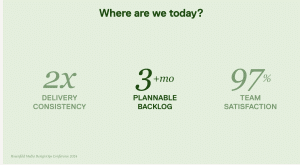
— Today we have 3+ month planning for sprint backlog, and exciting outcomes, with very high team satisfaction
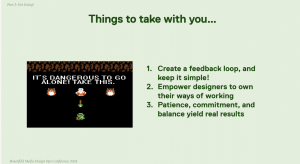
— As you head off into ops wilderness, remember the three things I mentioned here
- Create an initial feedback loop and keep it simple
- Empower designers to own their ways of working
- Patience, commitment, and balance yield real results—they just need time to be implemented
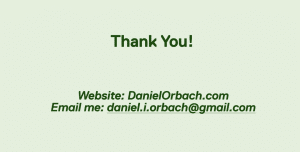
—Thank you so much, and hope you could take something away
Q&A
- Why can’t JP Morgan’s DesignOps team of 70 support 900 designers, given expected support ratio of 15:1?
- I’ll invoke analogy of map and territory, where details of operations and needs of other teams matter— which causes us to allocate resources where teams need the most help
- Operational excellence often occurs in pockets and we need to distribute against that
- And we can’t exempt ourselves from thinking critically about context we are in
- Have you dealt with failure of pulse surveys to capture team sentiment? How else have you gotten sense of where people are?
- I personally hope people aren’t tanking the surveys
- Would say you should think how you show up as leader — the Trust Equation from the Trust Advisor consultancy comes to mind
- When you see people being uncomfortable letting them share what they think and feel can help you meet them where they are at
- Example of deviation in pulse survey drove change?
- Yes, we had question in survey of: “Do feel you are working on your development goals?
- The answer was ‘not really’
- At the time we had only one design VP leading everything, but I realized needed associates had to lead more, and for VP to work through them, and not on them
- Being given greater autonomy was a transformative experience for associates
- Yes, we had question in survey of: “Do feel you are working on your development goals?
- I’ve found a process can be set-up, but a company culture renders it useless. Relationship between culture and process and order you pursue them in?
- I view situation as flywheel— The team had a bad culture when I started and simple process and reset allowed new culture to start forming
- Processes are the scaffolding for a team culture to grow on
- Facilitate process that promotes the culture you want to have
- Once a model established, how do you scale up and get buy-in from other teams?
- Documentation is great answer. Record all deliverables in Confluence
- Dialogue around work the team is doing, to help proselytize the work
- And send out emails to org with what we have delivered and other teams ask us questions
- Documentation is great answer. Record all deliverables in Confluence
- How to create consistent process for cross-team collaborations?
- Did this on the onboarding project and convening any group
- A team is not just boxes on org chart
- Conversation on norms and cadence on conversation on teams of teams
- Come back to idea of autonomy and laying out expectations and empowering team to bring back answer for you— as opposed to prescribing a solution for them to carry out
- Did this on the onboarding project and convening any group

